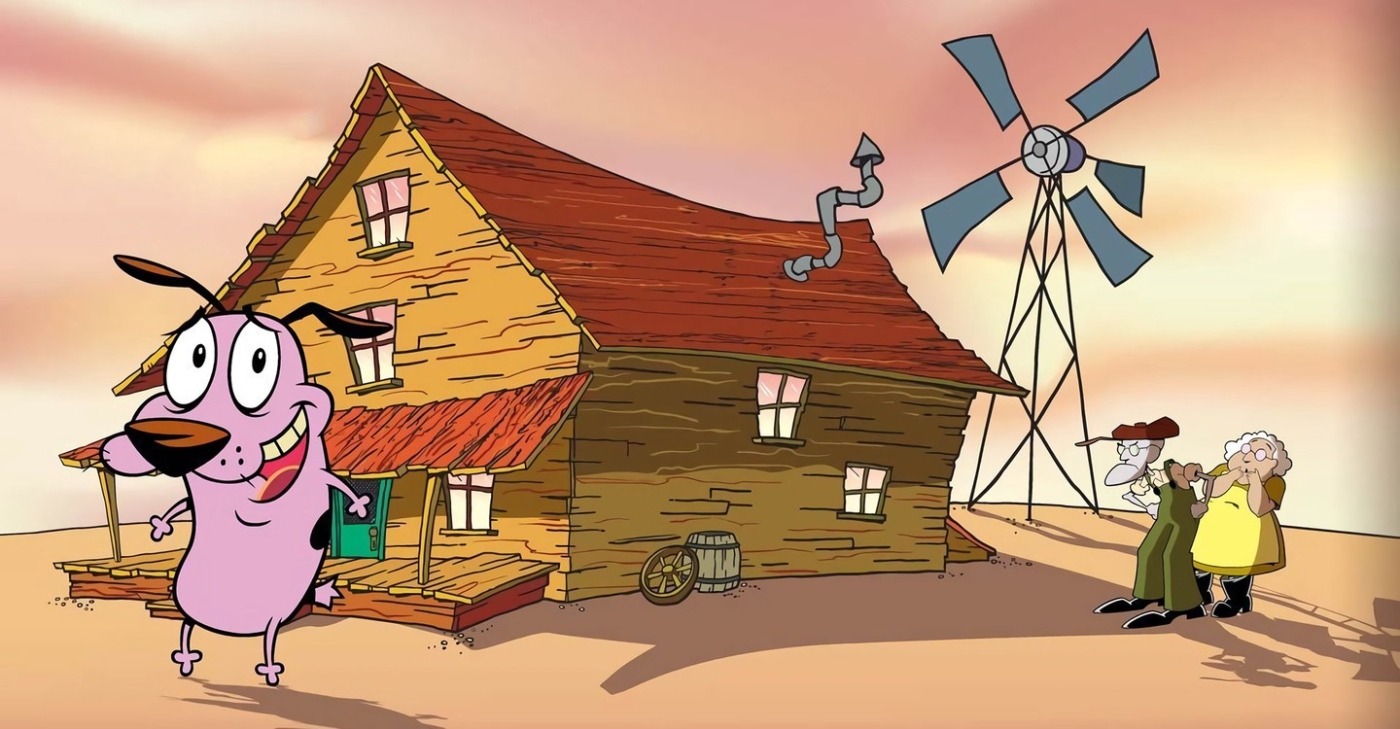The terrifying brilliance of ‘Courage the Cowardly Dog’
I love horror, and I have done since I was a kid. I remember lapping up the yearly Simpsons ‘Treehouse of Horror’ episodes, and every day after school, I would come home and watch Scooby-Doo in all its variants. But my favourite show was one that I keep revisiting, and I’m continually shocked at how terrifying and mature it was – Courage the Cowardly Dog. If you’ve never seen the show, there’s no better time than Halloween to explore its unique brand of visual inventiveness, dark humour and horror.
The show follows an elderly couple called the Bagges, who live in a farmhouse in the middle of Nowhere with their dog Courage. Muriel is sweet-natured and Scottish, and Eustice is grumpy and selfish, regularly mistreating Courage out of jealousy. It’s an odd pair of human characters for a kid’s show, but it works. Every week, Courage must put aside his fear to protect his oblivious owners from all manner of supernatural threats, aided only by a sarcastic sentient computer.
It’s hard to describe, but it is so distinctly its own thing – Courage sets out the kind of world it wanted to create, and embraces it whole-heartedly
If that sounds bizarre, that’s only scratching the surface. Creator John R. Dilworth has listed some of his varied inspirations in the past – Courage obviously draws a lot from classic horror and sci-fi films, but it also owes a lot to Salvador Dali and Tex Avery in how its visuals fused the cartoon with the abstract. It’s hard to describe, but it is so distinctly its own thing – Courage sets out the kind of world it wanted to create, and embraces it whole-heartedly. There’s a clear aesthetic and sound to this show that is totally distinct. It was never afraid to be scary or funny, and often carefully balanced the two.
That said, there’s a lot of stuff here that was truly the stuff of nightmares. I could throw out a long list of horrifying villains, from the Queen of the Black Puddle to an evil foot fungus that sounds like James Cagney, and I wouldn’t do the show justice. Dilworth also mashed art styles to heighten the sense that the villains did not belong – think of the CGI Ramses shouting “return the slab” in a high-pitched voice, or the live-action face of the Harvest Moon with its black, dead eyes. And few TV characters have ever been as disturbing as the “naughty” Freaky Fred. That I remember so many of the monsters so many years later is a testament to how effective they were.
As I rewatch Courage now, I’m shocked at some of the themes the show addressed that I never noticed as a kid. ‘The Mask’ was a story about domestic violence and it featured what was hugely implied to be a LGBTQ+ relationship, something that was still infrequent 20 years ago. ‘The Tower of Dr. Zalost’ was a case study about depression and how it can impact your life (and it features one of the most haunting musical themes I’ve ever heard). The villainous Katz and the zombie director Benton Tarantella were explicitly serial killers in a show meant for children.
That I remember so many of the monsters so many years later is a testament to how effective they were
Not all of the monsters were that evil, however – many turned out to be friendly or misunderstood, and that’s a very important lesson for children. In ‘The Shadow of Courage’, for example, it turns out the shadow of a bitter scientist is only acting out because it wants to pursue a life of showbiz. In an interview, Dilworth explained that developing the villains, giving them hopes, dreams and fears, made for a stronger show, because these characters – bizarre as they were – felt more real as a consequence.
He said: “I don’t portray psychopaths. That’s a different monster altogether, and those don’t interest me. We are talking about the villain and I’m very much interested in the repressed traumas of villains, even of protagonists. I have stitched together a vague history for Eustace that he was unloved by his mother. She preferred an older brother and there was the effect of that in Eustace. I’ve explored that in a few cartoons. So, the idea of going deeper, trying to assign an etymology of bad behaviour to childhood trauma is based on actual science. That’s the science of psychiatry.”
The 90s and the early 2000s were a very strange time for kid’s shows – they were willing to push the boundaries in a way that hadn’t been seen before
When you look back, the 90s and the early 2000s were a very strange time for kid’s shows – they were willing to push the boundaries in a way that hadn’t been seen before, and hasn’t been seen since. Courage the Cowardly Dog was the best example of this trend – it was bizarre and scary, and it loved to experiment with the kinds of shows it told and how it told them. And yet, it was often funny and very full of heart, and Courage has deservedly become an iconic cartoon character in his own right. If you’re struggling for some viewing ideas come Halloween, why not check the show out, and prepare for something unlike anything else you’ve seen.

Comments (3)
Love to courage the cowardly dog and Eustace Bagge and Jean Bonnes the hamburger pig who tries to take you below stairs into an evil place!
I still gave the “return the slab” nightmares to this day and I’m 26, one of my biggest childhood fears haha
A wonderful but scary story that still haunts me to this day! RETURN THE SLAB! Amazing work from Dilworth! I’m to this day an avid fan of Courage the Cowardly Dog! I love Courage and Eustace Bagge!